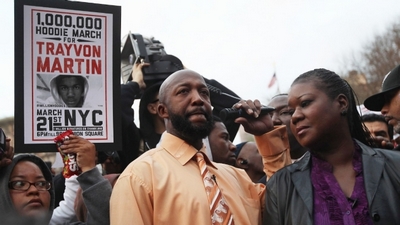
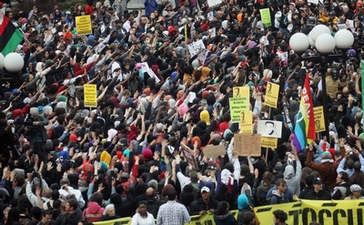
Triggers and Surges
January 8, 2011 a person shot and killed six people and wounded 13 at a neighborhood meeting of an Arizona member of the House of Representatives and her constituents. Representative Giffords was shot, but was not killed. And that precipitated a huge communication surge. Television, newspapers, and radio covered the event in detail. The new media were swamped with communication about the event. Within a few days hundreds of thousands of Twitter messages mentioning Representative Giffords were posted. Shooting a member of congress precipitates a huge surge of communication that lasts weeks. (Boynton and Richardson, )
On February 26, 2012 Trayvon Martin, a 17 year old black young man, was walking home from a convenience store when he was stopped then chased and finally shot and killed. The person who killed him was a self appointed neighborhood watch person carrying a gun, which is legal in Florida. The man who killed Trayvon claimed that he shot in self defense, and the police had little evidence to suggest the claim was false. And it did not precipitate a flood of communication. Aside from family and friends there seemed to be few concerned about the shooting. It is difficult to find news reports from the days immediately following the shooting and Twitter messages were too few to 'register.' But three weeks later there was a very large surge in communication about Trayvon. The images show a large demonstration in New York city -- the million hoodie march for Trayvon.
 |
 |
The left image is his parents and the sign for the demonstration. The right image gives an idea about the size of the crowd that gathered. Twitter messages tell the same story.
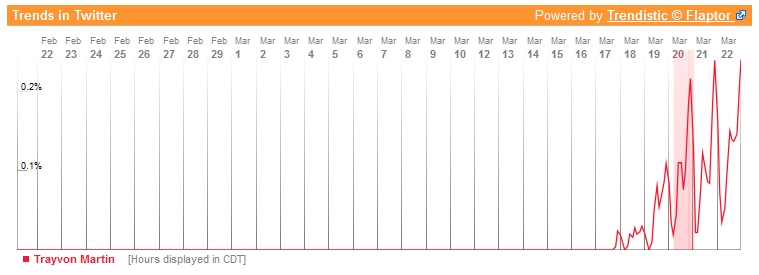 |
The time line in the figure is for the month from February 22 through March 22. He was killed on the February 26th, but messages posted to Twitter only start on the 17th of March. Then there is an increasing surge each day through the 22nd.
If the shooting did not do it what did? By the 17th the police department in Sanford, Florida had released a tape of a conversation between the shooter and the police when the shooter called 911 to report a suspicious person walking through the neighborhood. In that message the police person told him not to follow, which was a request he ignored. But there was still no evidence about the nature of the shooting. Then on the 16th of March a phone record of the event was released. Trayvon was talking on the phone with his girlfriend during the entire event. From that record it was clear that the shooter was the aggressor in the situation. He chased. He caught. He challenged. And he shot.
The phone record was public. It was linked to message after message. You could listen to the voices, and you could hear the shot. And Trayvon Martin became a reminder to the society that it is still dangerous for a black man to walk down the wrong streets. (Robinson, 3/22/2012) And that phone record was the trigger for the surge in communication and action that followed.
This is three months of Twitter messages mentioning Iran.
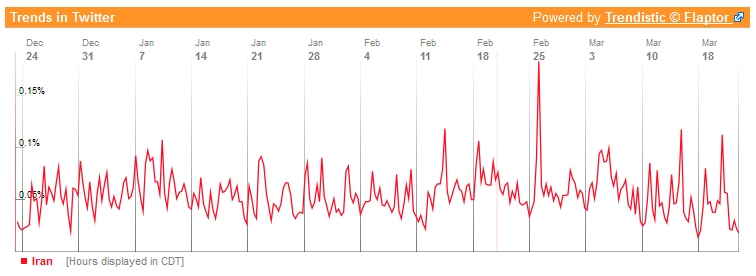 |
In the three months there is variation from day to day, but it looks like highs and lows around a pretty stable mean except for February 25. On that date there was a surge of Twitter messages about Iran. What happened? The New York Times reported that U.S. "intelligence analysts" saw no move by Iran to build a nuclear bomb. (Risen and Mazzetti, 02/25/2012) The Times also summarized a report of the International Atomic Energy Agency that suggested Iran was moving to produce nuclear fuel more quickly than expected. (Sanger and Broad, 2/25/2012) And The Guardian reported that Iran warned Israel not to attack it's nuclear facilities. (Pearse, 2/25/2012) So Twitter messages mentioning Iran were varying within a relatively narrow range except for a one day surge. My hunch is TheGuardian report was the driver. Israel and almost any threat generates a very large surge of messaging.
One more instance of triggers and surges. The figure below shows the number of Twitter messages per day mentioning Bachmann, Perry and Romney between the beginning of August and the end of November of 2011.
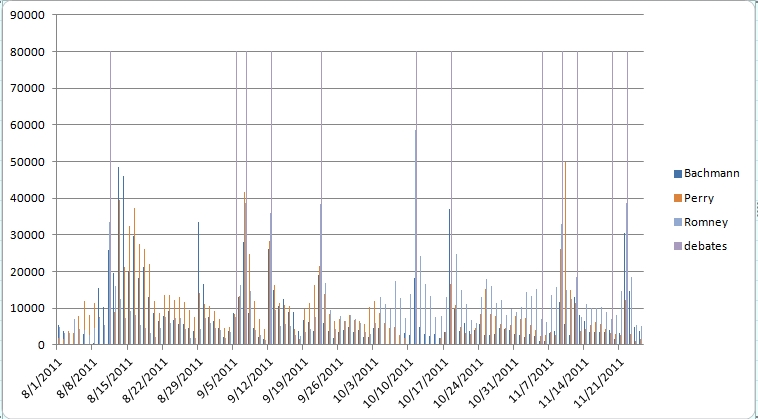 |
The very tall spikes are the dates of the televised debates. Almost all of the spikes in the timeline were triggered by a debate. Clearly attention and communication about the candidates sharply increased as a result of the debates and then fell after the debate was over. The results would have been the same if the other candidates had been included, but the figure would be so full it becomes difficult to see small variations. Generally, the surge is not limited to the day of the debate. There is some build up and then a falling away, but the center of the surge and decline is the debate.
Surge and decline are frequent in Twitter messages about politics. Some are violent events like the two shootings. Some are as 'regular' as shifting attention coordinated by a debate schedule. They are all about shifting attention. If we are going to understand Twitter messaging about politics shifting attention is going to be central to our theorizing and research.
References
Boynton, G. R. and Glenn Richardson (2011) The Language of Threat in Our Political Discourse
Pearse, Damien (2/25/2012) Iran warns Israel not to attack its nuclear facilities, TheGuardian
Risen, James and Mark Mazzetti (2/25/2012) U.S. Agencies See No Move by Iran to Build a Bomb, The New York Times
Robinson, Eugene (3/22/2012) Trayvon Martin and dangerous times for black men, The Washington Post.
Sanger, David and William J. Broad (2/25/2012) Atomic Agency Says Is Making Fuel at Protected Site, The New York Times.
© G. R. Boynton, 3/23/2012